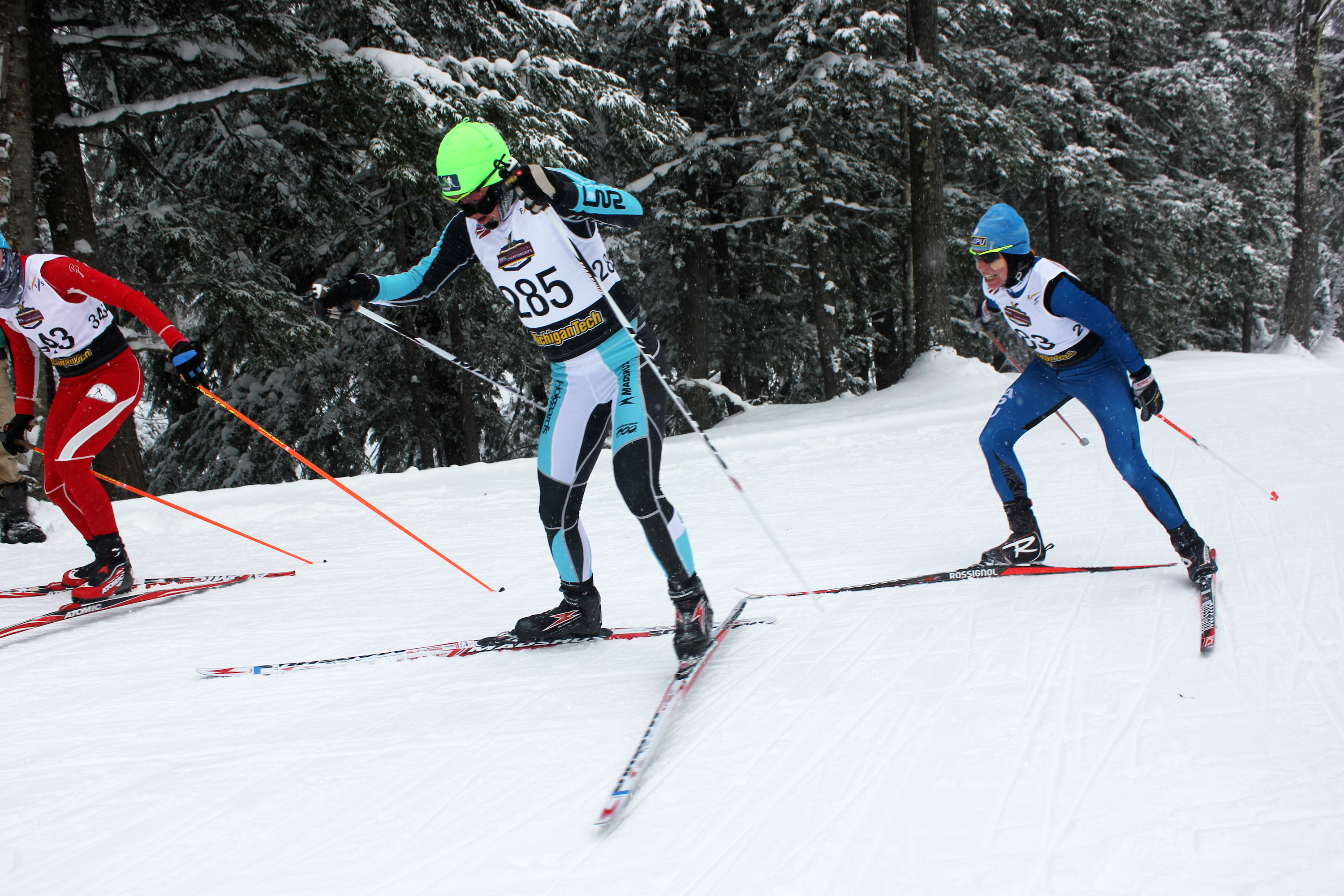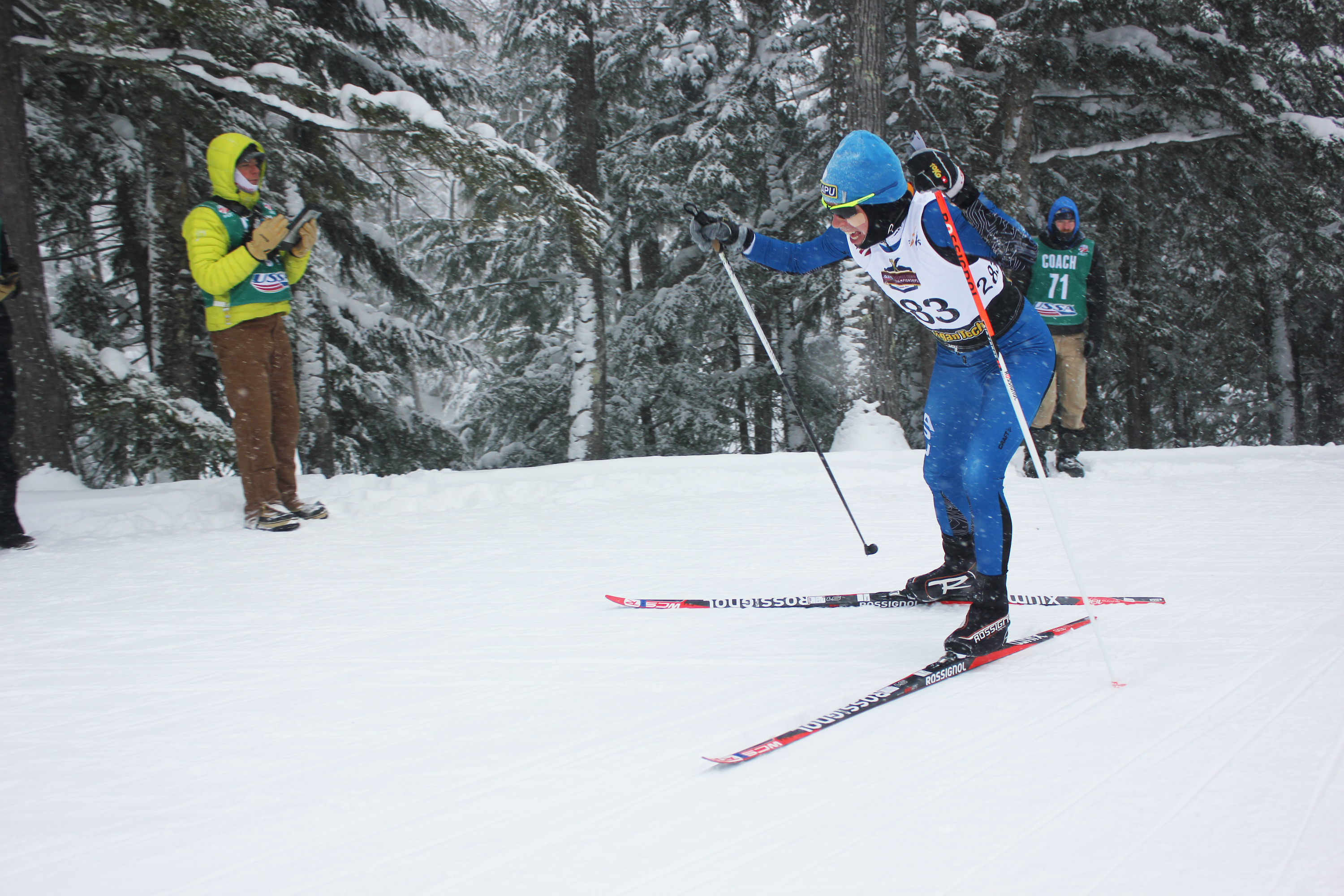
HOUGHTON, Mich. – Individual starts are often considered less exciting than their mass start counterparts, but the women’s 10-kilometer freestyle at the 2015 U.S. Cross Country Championships proved they can hold just as much exhilaration.
Caitlin Gregg of Team Gregg/Madshus won the race with a time of 30:31.5, roughly 12 seconds ahead of the next competitor. What the results don’t say, however, is how Gregg earned her first victory of the season.
Two of the competition’s favorites, Gregg and current Super Tour leader Rosie Brennan, of Alaska Pacific University (APU), started 30 seconds apart with Brennan donning 283 and Gregg 285. Gregg would have to gain on Brennan if she had any hope of winning, while Brennan needed to ensure that Gregg didn’t make up any ground.
At roughly 1 k into the race, misfortune hit Brennan as she planted a pole between in her ski and fell face-first into the snow. Getting up quickly, Brennan tried to pole again but face-planted for a second time before realizing her pole was broken.
While she retrieved a replacement, it was too big, causing her to ski in a lopsided manner. She didn’t receive a smaller one until two or three k later when she passed her APU coach, Erik Flora.
At that point Gregg had already made up the 30-second deficit.
“I was definitely a little flustered and then Caitlin caught me as a result. I tried to just relax and tell myself that she could be winning by a minute,” Brennan said in a post-race interview.
Now skiing together, the two competitors worked in tandem to battle the slow terrain resulting from cold temperatures and blowing snow.

“I was really fortunate because Rosie Brennan had a crash and broke her pole and so I caught her. Skiing behind someone is a lot easier so I got a good ride with her. We switched on and off,” Gregg said after the race.
After the two reached the middle of the second 5 k lap, Brennan explained that she decided there was nothing to lose, and took off in an attempt to earn back the 30 seconds she lost to Gregg.
“I felt a lot better in the second lap. I pulled myself together and I found the fitness I was looking for,” she said of her last-ditch effort.
While she pulled away and finished a sizable distance ahead of Gregg, it wasn’t enough to bridge the 30-second gap, and Brennan ultimately finished 12.6 seconds back for third place behind Gregg and APU teammate Chelsea Holmes in second.
“It makes me feel frustrated, but also happy that I have the fitness I thought I did,” Brennan said of the day.
Flora, who has coached Brennan for several years, explained that he was proud of his skier even though she was unable to demonstrate her full potential.
“She is in good racing form. The pole thing, that is unfortunate, but I guess that is racing. She did well, really well considering everything,” he said after the race.
Attributing much of her success to the fast skis and her ability to fight in adverse conditions, Gregg explained she’s often at her best on a restless course like Houghton’s and that slow conditions like Sunday’s bring out her best skiing.
Gregg, who recently returned stateside after competing on the World Cup this fall, said that she hasn’t felt like herself this year but that Sunday’s race was a step in the right direction. She explained that after being near the back of the pack in Europe, seeing her name at the top of the result sheet was a confidence booster.
“The idea of being towards the front of the result sheet – that’s a lot better for sure, psychologically.” She said pointing out that she’s still searching for her highest gear but that she’s “optimistic in the sense that this year can really get better.”
Prior to Sunday’s race, Gregg explained that a possible reason for her poor results on the World Cup came in the form of shingles. Having contracted the illness upon arriving in Europe, Gregg said that she often felt drained of energy while racing against the best in the world.
“It wasn’t until the second weekend in Davos, when it was a 10K Skate race at altitude and should have been my best race, that I realized the virus might have zapped me a bit more than I thought. I am still not sure if it had any affect on my race results though?” she wrote in a previous email.
Gregg explained the 10 k at nationals marked an improvement in her energy — in Europe she would often tire after 3 k of racing while in Houghton she said it was after 7 k where her drive started to wane.
In second place, Holmes (+12.1) also said that Sunday’s race didn’t “feel great,” but chalked it up to the slow snow and arctic winds. She explained that the near zero-degree temperatures motivated her start and finish her race as fast as possible, so that she could stay warm.

Holmes joined the APU squad this fall after skiing for Sun Valley in the 2014 season. Flora said that while fall is often too late for skiers to join his team, the combination of familiarity with Holmes and her roots in Girdwood, Alaska, won him over.
“She’s awesome; lots of energy, good enthusiasm, hard trainer, and brings a lot of really good distance skills to our group and so it helps balance the team. We have a few good sprinters, a few good classic skiers, and a few good skaters, so having Chelsea on our team is great,” he said of the 27-year-old Holmes.
Caitlin Patterson (+32.2) of the Craftsbury Green Racing Project finished fourth, and said that she was hoping for a better performance. She explained that unusually icy conditions in her hometown of Anchorage, Alaska, had her used to fast skiing with long glide, resulting in a rough transition to the slow snow in Houghton.
“It’s interesting coming from Anchorage where we were skiing on ice. That snow was so fast and I was working on V2ing up the hills and feeling like I could glide a lot. Here it’s hard to get a sense of whether I’m actually moving, when I’m feeling like I’m not gliding at all on the uphills,” she said.
Fifth-place finisher Jessica Yeaton (+32.8) cemented APU’s dominance in the women’s 10 k delivering the team’s third finish in the top five. Yeaton, who graduated from Montana State University in the spring of 2014 is a dual citizen of the U.S. and Australia. After racing in the southern hemisphere this past summer she is now a member of the national team who trains with the APU squad in Alaska. Later this winter she will compete abroad in several World Cups and the 2015 World Championships in February.
Yeaton, who had a self-described slow start to the season in the West Yellowstone and Bozeman SuperTours, said as soon as she caught 18-year-old superstar and eventual sixth place finisher Katherine Ogden, she realized she was having a good race. The pair skied together for the remainder of the competition playing what Yeaton called a “game of cat and mouse.”
And while the races in Houghton mean nothing for qualification or points for Yeaton, she explained that they were good practice for later in the season.
“I’m using U.S. nationals as good training races and it doesn’t really matter how I do here, but it does in the sense of building confidence,” she said.
With three skiers in the top five, Flora said his team’s success was attributed to the athletes’ motivation and camaraderie
“Today was probably the training, good teammates pushing each other, and all that good stuff,” he said. “Chelsea and Rosie we definitely expected them to be in the fight for the podium, but I think the big success of the day is Jessie Yeaton,” he said.
— Alex Kochon contributed reporting
Lander Karath
Lander Karath is FasterSkier's Associate Editor from Bozeman, Montana and a Bridger Ski Foundation alumnus. Between his studies at Middlebury College in Vermont, he is an outdoor enthusiast and a political junkie.



